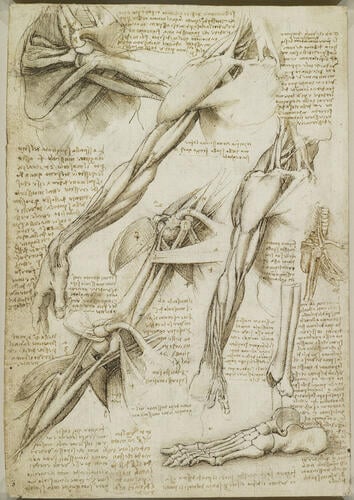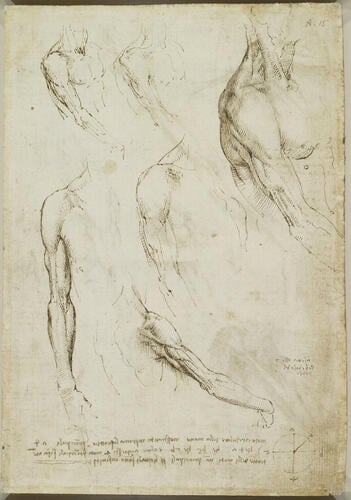-
1 of 253523 objects
The muscles of the shoulder and arm (recto); The muscles of the shoulder and arm, and the bones of the foot (verso) c.1510-11
Recto: Pen and ink. Verso: Black chalk, pen and ink, wash | 28.9 x 20.1 cm (sheet of paper) | RCIN 919013

Leonardo da Vinci (1452-1519)
The muscles of the shoulder and arm (recto); The muscles of the shoulder and arm, and the bones of the foot (verso) c.1510-11

Leonardo da Vinci (1452-1519)
The muscles of the shoulder and arm (recto); The muscles of the shoulder and arm, and the bones of the foot (verso) c.1510-11


-
A folio from Leonardo's 'Anatomical Manuscript A'. On the recto: three sketches, one on a larger scale, of a man's right arm and shoulder, showing muscles; three studies of a right arm; a diagram to illustrate pronation and supination of the hand.
*
On the verso: three drawings showing a deep dissection of the muscles of the shoulder region; two studies of the muscles of the shoulder and right arm; a diagram of the respiratory muscles; a skeleton of a left foot with leg bones; notes on the drawings.
This is one of the densest and most majestic of Leonardo’s anatomical sheets, and once again the focus is the structure of the shoulder and arm. The largest drawings at upper centre and centre right show the same stage of dissection from a slightly different aspect; the muscles and tendons of the forearm, especially those that act upon the thumb, are exquisitely drawn. In the drawing at the centre of the page, the deltoid is lifted away and the upper and lower portions of pectoralis major removed (the sternal portion remains) to reveal more of the shoulder joint, showing clearly the attachment on the coracoid process of pectoralis minor, coracobrachialis and the short head of biceps. These structures are represented (in a lateral view) in the ‘thread diagram’ at centre right, with a note that attempts to explain the mechanism by which the cavity of the chest expands, tracing a chain of muscular action from the first vertebra of the neck, through trapezius, the clavicle, the coracoid process and pectoralis minor to the ribs. There must have been great satisfaction for Leonardo in explaining how this structure worked as a unit – but in reality none of these structures significantly effects the expansion of the chest.
At lower left, the sternal portion of pectoralis major has been reflected to the side of the humerus, and the axillary nerve and posterior humeral circumflex vessels can now clearly be seen streaming into the region from the neck. Leonardo reminds himself ‘In the fourth diagram, lift off the fish of the arm [biceps] and describe what remains’, and the continuation of this series of dissection views can be seen on 919003v.
The drawing at upper left of this sheet is one of Leonardo’s less successful depictions of the shoulder – the curvature of the clavicle is exaggerated, and the acromion is shown as a separate bone.
The drawing of the bones of the foot at lower right is one of a series of similar studies scattered throughout Manuscript A.
Text from M. Clayton and R. Philo, Leonardo da Vinci: Anatomist, London 2012Provenance
Bequeathed to Francesco Melzi; from whose heirs purchased by Pompeo Leoni, c.1582-90; Thomas Howard, 14th Earl of Arundel, by 1630; probably acquired by Charles II; Royal Collection by 1690
-
Creator(s)
Acquirer(s)
-
Medium and techniques
Recto: Pen and ink. Verso: Black chalk, pen and ink, wash
Measurements
28.9 x 20.1 cm (sheet of paper)
Other number(s)